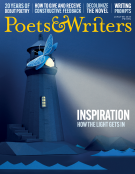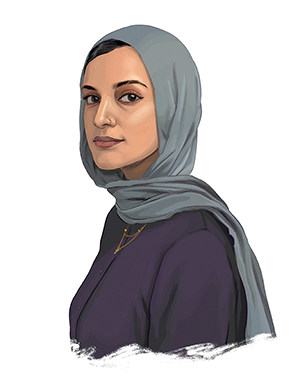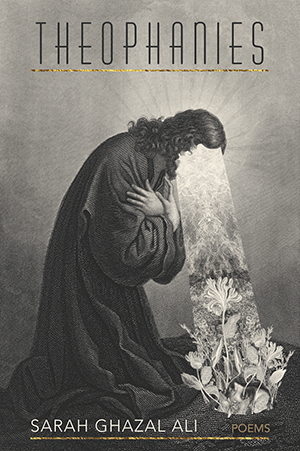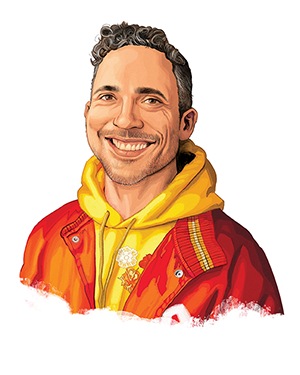Sarah Ghazal Ali
Theophanies
Alice James Books
(Alice James Award Editor’s Choice)
From a clot
I’ll make men. Hollow
myself holy.
—from “Self-Portrait as Epiphany”
How it began: There are a few different origin stories for this book, but I’ll share my early academic one. I was on the prelaw track in college and considered adding literature as a double major. When I took a course in ancient political thought, I was surprised to find the books of Genesis and Exodus on the syllabus alongside Thucydides and Aristotle. I didn’t know you could close read scripture in a political science class, let alone consider it a point of origin for political thought. It was a life-changing class for me, one where I felt free—and encouraged—to look more closely at the women in scripture and recognize their agency, their political choices. Soon after, I was given the prompt in a creative writing class to write about the origin of my name. Choosing my middle name, Ghazal, felt too obvious, so I chose my first name instead and wrote a persona poem in the voice of scriptural Sarah for the first time. I became obsessed with matrilineage and Sarah and, through her, the many women of sacred history across Abrahamic faiths that I could look to as models for my own living.
Inspiration: My mother; my mother’s hands; the specters of my grandmothers; my aunts; Mary and Mary Magdalene; Sarah/Sarai; the great white shark that beached at Pleasure Point in Santa Cruz, California; the land and seascapes of Santa Cruz; Max Richter; Urdu ghazals sung by my father; the rhythms of the Qur’an in Arabic; A Tree Grows in Brooklyn (Harper & Brothers, 1943) by Betty Smith; The Wild Iris (Ecco Press, 1992) by Louise Glück; the story of Prophet Yusuf/Joseph; the story of Yusuf and Zuleikha; Christian iconography and Islamic aniconism; the Arabic letters taped to the fridge in my childhood home; René Magritte; Sadequain; Whitney DeVos; June Jordan’s model of the engaged and unappeasable artist; Faiz Ahmed Faiz’s poetry written in solitary confinement; the chorus of competing adhans in Karachi; every dead bird I’ve found in my path; Vivaldi; Urdu nasheed; Urdu marsiya; and my faith, which never wavered for, and welcomed, my doubt.
Influences: Etel Adnan, whose sacred attention to Mount Tamalpais across text and image has bewildered me; Mary Szybist, whose work makes mine possible; Brigit Pegeen Kelly, whose peculiar, precise eye has sharpened my own; Mahmoud Darwish, whose rhythmic, piercing questions call forth new questions; Dan Hillier, whose visual art offers a face for my poems, whose art lives on beyond him, whose art I am unbelievably lucky to have as the cover of my first book.
Writer’s block remedy: If I feel burned out, I take a break from poetry and turn to other media. I rewatch comfort TV shows, and I read fiction until my well feels replenished, which I know has happened if my imagination feels alive and capacious again. Novels are my great love, and they help me step out of anxious, capitalist production mode—they remind me that I am a writer because I love, more than anything, to read. If I’ve reached an impasse but still feel the itch to write, I love reading/watching/listening to interviews and lectures by poets I admire. I consider myself a lifelong student, and spending time with them through their public speech always, always gets me fired up and eager to write again.
Advice: Write into and through your curiosities until you feel as if you’ve exhausted them. It doesn’t matter what anyone else is writing or how—your work is yours and it doesn’t need to fit anyone else’s mold. Read other poets’ first books, and second books, and third books. Don’t let the scarcity model get in the way of community building, of friendship. Cultivate a relationship to the page that has nothing to do with awards, recognition, or publication. And this is a big one: Only submit your manuscript to presses where you’d be thrilled to have it find a home. Do tons of research on the presses that have open contests or reading periods. What do their contracts look like? How is their publicity and marketing? Will your manuscript go through an editorial process? Is that important to you? Do they treat their writers with care? Ask around, then ask some more.
Finding time to write: I’ll answer as pre-mother me who wrote and published this book, because new-mother me is figuring this out all over again. My book evolved out of my MFA thesis, and it was the structure and pressure of weekly workshops that helped me write consistently and without much overthinking. Then the pandemic began in the middle of my time at graduate school, and the return home to California offered a new kind of pressure and intensity. The lockdown gave me time to myself, and after resting I took countless online poetry workshops that cropped up in the spring and summer of 2020. It was a period of intense drafting, and I don’t know that anything like that will ever be possible for me again—the circumstances were so unique, almost desperate, because it really did feel for a while like everything as I knew it was coming to an end. I had to write because what if, very soon, I couldn’t anymore? Now, with a toddler, I don’t know what time is. The only time I’ve been able to write has been on a writers retreat when I was away from home and the demands of motherhood for a few days. Those opportunities will be far and few between, at least for now, but that’s just the season of life I’m in.
Putting the book together: I wanted to create an even and balanced experience for the reader. A visual approach helped me see the clusters across theme, imagery, form, and so on. I printed the poems out and taped them to a wall in my apartment. For months I let them just exist on the wall until I stopped feeling precious about them. Then I mapped them using different-colored sticky notes. I identified recurring images and themes—faith, eyes, sex, Sarah, and so forth—and assigned each a color. Poems in traditional and invented forms (like the three “Matrilineage…” poems) were given another label. This helped me ensure that there weren’t too many “green” Sarah poems at the front of the book, or too many “pink” dead animal poems all at the end. It was important to me that the book began by beseeching, and ended on a hopeful note; the opening and closing poems were clear to me early on. I also used the book Ordering the Storm: How to Put Together a Book of Poems (Cleveland State University Poetry Center, 2006), edited by Susan Grimm, which offered a variety of perspectives on sequencing a book of poetry.
What’s next: Time management as a mother and a professor, and being present for my family and my students. I don’t have the required distance yet from the subject I need to write into to better come to terms with it—vague, but I don’t have the distance to write about it even here. I am working on finding a sustainable path back to poetry and away from the corrosive pressure of publication. I’m also working on settling into a new home in Minnesota away from my family and friends, and getting accustomed to the new rhythms of my life, which looks very different from what it was a year ago.
Age: 28.
Residence: Saint Paul.
Job: I’m an assistant professor of English at Macalester College, as well as the poetry editor of West Branch.
Time spent writing the book: Altogether it took seven years to write and edit these poems. The oldest poem, one I consider the initial seed of what would become Theophanies, was written in 2016 not long after the election. That poem didn’t remain in the book, though it revealed my obsessions to me.
Time spent finding a home for it: About four months. I began submitting the manuscript in September 2021 and received my first acceptance the following January.
Recommendations for recent debut poetry collections: Self-Mythology (University of Arkansas Press) by Saba Keramati, Ward Toward (Yale University Press) by Cindy Juyoung Ok, The Girl Who Became a Rabbit (Hub City Press) by Emilie Menzel, and Pentimento (Black Lawrence Press) by Joshua Garcia. I feel incredibly lucky to share a debut year with these brilliant, innovative poets.
Theophanies by Sarah Ghazal Ali.
![]()
Yaguareté White
University of Arizona Press
My brothers and I
stand there aghast,
like straight men or suckers.
Like three gringo amigos
made up like mariachis.
—from “Abuelo Delouses Mister”
How it began: I have always written about language, family, inheritance, and heritage as it pertains to my own experiences as a Paraguayan American. But the birth of my child fundamentally changed my relationship to all those themes. New futures unfolded in the poems through the prism of parenthood. I came to see this new generation as another dimension to the text, one through which I could envision new possibilities, new liabilities, new dangers, and new forms of abundance. What had been a loose collection of poems really catalyzed into a cohesive book, one that wouldn’t exist in the same way without her.
Inspiration: I am especially inspired by the built environment around me. Whether it’s a converted chicken coop off the grid at Firefly Farms in Knoxville, Tennessee, or the messy tangle of pre-grid streets that quickly succumb to Manhattan’s rectilinear latticework, I find myself most inspired to write when I can immerse myself somewhere new. That said, the most beautiful places I’ve been privileged enough to visit are los campos outside my father’s hometown of Villarrica, where the landscape is defined by great expanses of rolling hills, birch trees, and sugarcane sparsely marked by makeshift homes and termite spires. I’m endlessly fascinated by humans’ architectural interventions in physical space. This expansiveness reminds me that poetry, too, exists within a particular time and place yet contains the potential for boundless imaginaries.
Influences: Rigoberto González, for his generosity, guidance, and kindness. Jorge Carrera Andrade, for his gift of concision. The textile art of eco-feminist Faith Wilding is with me, often recently, as I poke new frontiers within my own Paraguayan American artistry. I think about “Untitled (Perfect Lovers)” by Félix González-Torres a lot.
Writer’s block remedy: If I’ve held on to a piece of writing for a while and find trouble progressing, it’s usually time to share it with readers I trust. Conversely, if I’m not getting what I need from repeatedly workshopping a piece, it may need to rest with me for a spell. But more often than not I struggle with procrastination, so my problem is not so much confronting impasses as it is actually reaching them in the first place.
Advice: Prioritize presses and publishers putting out work that really resonates with you. Forget about any perks or prestige—real or perceived—that attend the more popular names in poetry. One of the most useful rejections I received was from a contact at a big literary house who passed on my book and cited the “pressures” of working with a Big Five publisher. I didn’t appreciate it at the time, of course, but I’ve come to understand the many advantages of collaborating with a small team of dedicated folks, especially within the interdisciplinary environment of an academic press.
Finding time to write: I write poetry almost exclusively in fits of inspiration that strike around eleven at night. I’ll get maybe an hour or two in before fading. It wasn’t always this way, but parenting plus teaching full-time squeezes my daily writing schedule down to admittedly thin wedges of the clock on any given day.
Putting the book together: I handed early drafts to poet friends and former professors whose opinions I trust and they helped me with big picture organizational decisions, like section breaks and thematic arcs, which allowed me to then focus on more granular moments of symmetry and continuity. There are a few places where one poem leads to the next or reiterates a word, phrase, or image from elsewhere in the book. This was important to me, to create this kind of cohesion. It does mean that certain poems might not make as much sense outside the container of the collection, but that’s fine. After all, the only time anyone will encounter most of the poems is when they pick up or click on the book itself.
What’s next: I’ve become obsessed with Formula 1 motor racing. It started with binge-watching Formula 1: Drive to Survive on Netflix during the pandemic. I desperately needed a diversion from the horrors unfolding everywhere and quickly found myself deep into the Formula 1 rabbit hole. So, I’m writing a lot of F1 poems?
Age: 40.
Residence: Chicago.
Job: With luck, make this planet a better place for all its inhabitants who are not billionaires. For money I’m an assistant professor of Multidisciplinary Studies at the City Colleges of Chicago.
Time spent writing the book: One of the oldest poems, “The Skin,” dates to around 2008. I think the most recent poem is “Punchline,” which was still a blank placeholder page until almost right up to the date we approved final proofs. So close to fifteen years.
Time spent finding a home for it: I spent two years (2020–2022) investing a fortune submitting to every prize, contest, and open reading period I could find. The book got two little nods, I believe, which is nice. When the opportunity to be published by the University of Arizona Press, as part of its Camino del Sol series, presented itself, I jumped at the chance.
Recommendations for recent debut poetry collections: Santa Tarantula (University of Notre Dame Press) by Jordan Pérez, Self-Mythology (University of Arkansas Press) by Saba Keramati, The Span of a Small Forever (Amistad) by April Gibson, The Sky Was Once a Dark Blanket (University of Georgia Press) by Kinsale Drake, and My Limbs a Cradle, My Whisper a Song (Finishing Line Press) by Cathy Gilbert.
Yaguareté White by Diego Báez.












